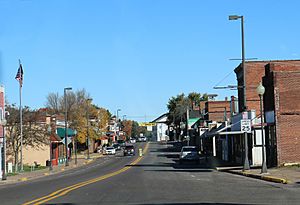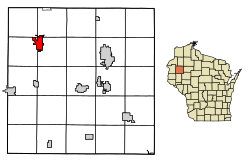Cumberland, Wisconsin facts for kids
Quick facts for kids
Cumberland, Wisconsin
|
|
|---|---|
|
City
|
|

Downtown Cumberland
|
|
| Nicknames:
Wisconsin's Island City, or C-Town
|
|

Location of Cumberland in Barron County, Wisconsin
|
|
| Country | |
| State | |
| County | Barron |
| Area | |
| • Total | 4.57 sq mi (11.83 km2) |
| • Land | 3.98 sq mi (10.32 km2) |
| • Water | 0.58 sq mi (1.51 km2) |
| Elevation | 1,243 ft (379 m) |
| Population
(2020)
|
|
| • Total | 2,274 |
| • Density | 497.6/sq mi (192.22/km2) |
| Time zone | UTC-6 (Central (CST)) |
| • Summer (DST) | UTC-5 (CDT) |
| Area code(s) | 715 & 534 |
| FIPS code | 55-18025 |
| GNIS feature ID | 1563618 |
| Website | http://www.cityofcumberland.net |
Cumberland is a city in Barron County, Wisconsin, in the United States. It's often called the "Island City" because a big part of it is surrounded by Beaver Dam Lake. In 2020, about 2,274 people lived here. The city was officially started in 1885.
Contents
History of Cumberland
Cumberland is known as the "Island City" because its main area is on land surrounded by Beaver Dam Lake. The Chippewa Indian tribe originally lived here. They called Beaver Dam Lake "Che-wa-cum-ma-towangok," which means "Lake Made by the Beavers." The chief of the Chippewa tribe was named Pon-gee Rau-gen, or "Little Pipe." He lived in the area even after new settlers arrived.
In 1874, A. Ritan and R. H. Clothier explored the area. They met surveyors who told them about a new railroad line coming soon. A. Ritan and the Dahlby family built log cabins near where the railroad was planned.
The North Wisconsin Railroad Company built its tracks through the area in 1878. Before the railroad, settlers had to travel far to get supplies. In 1880, the Dahlby family moved away. A. Ritan helped develop Cumberland for many years.
The town was first called Lakeside and was set up on December 30, 1875. A school was built on the mainland near a bridge. Miss Carrie Fay was an early teacher. On January 1, 1880, the town's name changed to Cumberland. This was at the request of John Humbird, who came from Cumberland, Maryland.
A post office, first called Lakeland, opened in early 1876. Mae Jenet Hodgkin was the first white person born on the island in September 1876. David Ingle opened the first grocery store, and Elmer Wisner started the first blacksmith shop in 1878.
In July 1880, Dr. William Hopkins arrived and opened a medical practice. It was the only one between Clear Lake and Lake Superior at the time. A sawmill was built in northern Cumberland but was later destroyed by fire in 1884. The Lakeside Cemetery was also started in 1880.
The first newspaper, the Cumberland Herald, began printing in 1881. The first bank, the Bank of Cumberland, opened in 1883. As more people arrived, the city grew quickly. By 1885, a jail and a fire department were set up.
In 1895, the city built a water system. Telephone lines were also put up that same year. In 1897, the city approved electric street lighting. The Uecke's Opera House opened in 1903. A large school was built on the island that same year.
In 1905, Andrew Carnegie donated $10,000 to build a Carnegie Library in Cumberland. In 1914, Dr. George Grinde created the Island City Hospital. It had 20 beds and X-ray equipment.
Geography of Cumberland
Cumberland is located at 45°32′9″N 92°1′24″W / 45.53583°N 92.02333°W. It sits along Beaver Dam Lake, where the Hay River begins.
The city covers about 4.04 square miles (10.46 square kilometers). Most of this area is land, and a smaller part is water.
Major roads like U.S. Highway 63 and Wisconsin Highway 48 pass through Cumberland.
Cumberland's Climate
Cumberland has a climate with warm summers and cold, snowy winters.
| Climate data for Cumberland, Wisconsin, 1991–2020 normals, extremes 1932–present | |||||||||||||
|---|---|---|---|---|---|---|---|---|---|---|---|---|---|
| Month | Jan | Feb | Mar | Apr | May | Jun | Jul | Aug | Sep | Oct | Nov | Dec | Year |
| Record high °F (°C) | 54 (12) |
57 (14) |
80 (27) |
92 (33) |
104 (40) |
98 (37) |
107 (42) |
101 (38) |
95 (35) |
88 (31) |
74 (23) |
60 (16) |
107 (42) |
| Mean maximum °F (°C) | 38.9 (3.8) |
44.4 (6.9) |
59.2 (15.1) |
74.6 (23.7) |
82.6 (28.1) |
88.9 (31.6) |
89.7 (32.1) |
89.2 (31.8) |
84.5 (29.2) |
75.9 (24.4) |
58.7 (14.8) |
43.1 (6.2) |
91.8 (33.2) |
| Mean daily maximum °F (°C) | 19.1 (−7.2) |
24.3 (−4.3) |
37.1 (2.8) |
51.6 (10.9) |
64.7 (18.2) |
74.7 (23.7) |
79.0 (26.1) |
76.9 (24.9) |
68.5 (20.3) |
54.0 (12.2) |
38.0 (3.3) |
24.3 (−4.3) |
51.0 (10.6) |
| Daily mean °F (°C) | 9.7 (−12.4) |
13.5 (−10.3) |
26.3 (−3.2) |
41.0 (5.0) |
54.4 (12.4) |
64.8 (18.2) |
69.2 (20.7) |
67.1 (19.5) |
58.3 (14.6) |
44.5 (6.9) |
30.0 (−1.1) |
16.5 (−8.6) |
41.3 (5.1) |
| Mean daily minimum °F (°C) | 0.3 (−17.6) |
2.7 (−16.3) |
15.5 (−9.2) |
30.4 (−0.9) |
44.0 (6.7) |
54.9 (12.7) |
59.4 (15.2) |
57.3 (14.1) |
48.1 (8.9) |
35.1 (1.7) |
22.0 (−5.6) |
8.7 (−12.9) |
31.5 (−0.3) |
| Mean minimum °F (°C) | −19.8 (−28.8) |
−17.1 (−27.3) |
−7.3 (−21.8) |
16.9 (−8.4) |
33.0 (0.6) |
43.1 (6.2) |
50.4 (10.2) |
49.1 (9.5) |
35.1 (1.7) |
24.2 (−4.3) |
7.0 (−13.9) |
−11.9 (−24.4) |
−22.3 (−30.2) |
| Record low °F (°C) | −43 (−42) |
−52 (−47) |
−37 (−38) |
−4 (−20) |
18 (−8) |
31 (−1) |
36 (2) |
30 (−1) |
19 (−7) |
6 (−14) |
−16 (−27) |
−39 (−39) |
−52 (−47) |
| Average precipitation inches (mm) | 0.95 (24) |
0.99 (25) |
1.69 (43) |
2.83 (72) |
3.84 (98) |
4.54 (115) |
4.47 (114) |
4.40 (112) |
3.61 (92) |
3.28 (83) |
1.86 (47) |
1.29 (33) |
33.75 (858) |
| Average snowfall inches (cm) | 11.4 (29) |
10.6 (27) |
9.2 (23) |
4.6 (12) |
0.4 (1.0) |
0.0 (0.0) |
0.0 (0.0) |
0.0 (0.0) |
0.0 (0.0) |
0.7 (1.8) |
7.1 (18) |
11.6 (29) |
55.6 (140.8) |
| Average precipitation days (≥ 0.01 in) | 8.6 | 6.3 | 7.1 | 10.4 | 11.0 | 11.3 | 10.0 | 10.0 | 9.6 | 10.2 | 7.9 | 8.8 | 111.2 |
| Average snowy days (≥ 0.1 in) | 7.8 | 5.5 | 4.0 | 2.0 | 0.1 | 0.0 | 0.0 | 0.0 | 0.0 | 0.6 | 3.5 | 7.3 | 30.8 |
| Source 1: NOAA | |||||||||||||
| Source 2: National Weather Service | |||||||||||||
Population of Cumberland
| Historical population | |||
|---|---|---|---|
| Census | Pop. | %± | |
| 1880 | 246 | — | |
| 1890 | 1,219 | 395.5% | |
| 1900 | 1,328 | 8.9% | |
| 1910 | 1,445 | 8.8% | |
| 1920 | 1,528 | 5.7% | |
| 1930 | 1,532 | 0.3% | |
| 1940 | 1,539 | 0.5% | |
| 1950 | 1,872 | 21.6% | |
| 1960 | 1,860 | −0.6% | |
| 1970 | 1,839 | −1.1% | |
| 1980 | 1,983 | 7.8% | |
| 1990 | 2,163 | 9.1% | |
| 2000 | 2,280 | 5.4% | |
| 2010 | 2,170 | −4.8% | |
| 2020 | 2,274 | 4.8% | |
| U.S. Decennial Census | |||
2010 Census Information
In 2010, Cumberland had 2,170 people living there. There were 994 households.
Most of the people living in the city were White (95.9%). There were also smaller groups of African American, Native American, and other races. About 2.5% of the population was Hispanic or Latino.
The average age in the city was 47.2 years old. About 20.8% of residents were under 18. About 24.9% were 65 years old or older. The population was slightly more female (53.7%) than male (46.3%).
Transportation
The Cumberland Municipal Airport (KUBE) is located about three miles south of the city.
Fun Things to Do in Cumberland
Cumberland is famous for being "The Island City" because it's almost completely surrounded by Beaver Dam Lake.
Every year, Cumberland hosts the "Rutabaga Festival." This fun event happens the weekend before Labor Day. It includes live music, carnival rides, tasty food, a parade, and many other activities.
Famous People from Cumberland
- Jules Alfonse – A player in the NFL
- Henry C. Doolittle – A Wisconsin State Representative
- David Hanson – A player in the NHL
- Fred J. Moser – A Wisconsin State Representative and Educator
- Ben Peterson – An Olympic Gold Medalist in wrestling
- John Peterson – An Olympic Gold Medalist in wrestling
- Thomas St. Angelo – A Wisconsin State Representative
- Sister M. Madeleva Wolff – A Poet and College President
- Roger A Towberman - Chief Master Sergeant, United States Space Force
Images for kids
See also
 In Spanish: Cumberland (Wisconsin) para niños
In Spanish: Cumberland (Wisconsin) para niños





